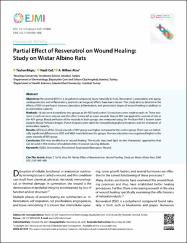Partial Effect of Resveratrol on Wound Healing: Study on Wistar Albino Rats
Citation
Bilgiç, T., Caf, N., Atsü, A. N. (2021). Partial Effect of Resveratrol on Wound Healing: Study on Wistar Albino Rats. Eurasian Journal of Medical Investigation, 5(4). ss. 460-468. DOI: https://dx.doi.org/10.14744/ejmi.2021.97868Abstract
Objectives: Resveratrol (RSV) is a polyphenol compound found naturally in fruits. Resveratrol's antioxidant, anti-aging, cardioprotective, anti-inflammatory, and anti-carcinogenic effects have been shown. This study aims to determine the effects of RSV on perfusion, neovascularization, inflammation, and granulation stages of wound healing in addition to its antioxidant capacity. Methods: 16 rats were divided into two groups as the RSV and control. Six excisions were made in each rat. Three exci sions in each rat were sutured and the other 3 were left as open wounds. Topical RSV was applied to wounds of rats in the RSV group. Blood perfusion of the wounds in both groups was measured using the PeriScan PIM 3 System Laser Doppler Blood Perfusion Imager. Punch biopsies were taken for histopathological examinations and the evaluation of antioxidant capacity. Results: GPX level of the closed wounds of RSV group was higher compared to the control group. There was no statisti cally significant difference in SOD and MDA levels between the groups. Neovascularization was registered higher in the open wounds of RSV group. Conclusion: RSV may be effective in wound healing. The results may shed light on new therapeutic approaches that can be used in the reversal of oxidative stress in wound-causing diseases.
Source
Eurasian Journal of Medical InvestigationVolume
5Issue
4Collections
- Makale Koleksiyonu [15]


















